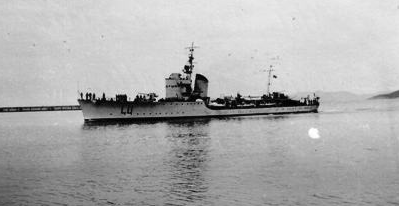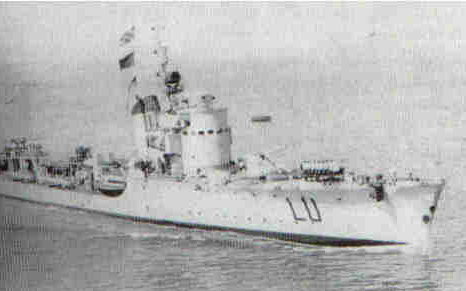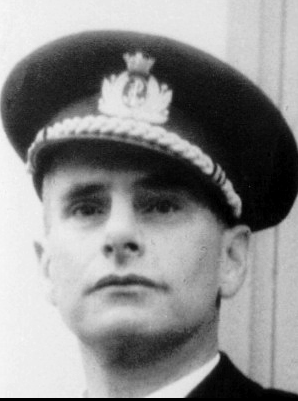May 22nd, 1941
The German plan for the occupation of Crete was ready since the end of April 1941. The invasion of the island would be the exclusive task of the German air force (Luftwaffe); paratroopers would occupy the enemy airfields where, later on, would land the 5th Alpine Division which would complete the occupation of the island. The plane gave little room to the German army, and even less to the Italian armed forces. A few days before the attack, German generals who depended heavily on surprise, changed the general plan and decided to organize secondary landings of alpine troops along the Cretan coast. The Regia Marina was asked to navigate, not escort, these landings since the Lufwaffe would have provided for the necessary coverage for these small boats full of soldiers, and would have “sunk any ship which dared to adventure itself close to Crete.”

The Torpedo Boat R.N. Lupo
At that time, the Regia Marina had limited resources available in the Aegean theater and only the 1st and 16th Torpedo Boat Squadron, 4 MAS, 13 minesweepers and a few submarines were assigned to this operation. On the 19th of May, one of these convoys left the port of Piraeus. It included 21 small boats, but 7 had to return to port due to technical failures. They were loaded with 2,331 soldiers of the III/100th Gebirgjaeger (alpine troops) and artillery personnel of the Luftwaffe. The torpedo boat Sirio was assigned to the convoy, but when her starboard propeller failed, she was replaced by the torpedo boat Curtatone. Unfortunately, this second unit sank on a mine while she was trying to reach the convoy. Ultimately, the torpedo boat Lupo was ordered to replace the Sirio and escort the convoy to Crete.
Engagement
The delay caused by the Sirio’s failure and the confusion amongst the boats, none of which was equipped with radio apparatuses or any other equipment needed for such a dangerous crossing, caused the Lupo to fail to locate the convoy until sunrise of the 21st. The commander of the small Italian unit, C.C. Francesco Mimbelli, after having instructed all units by means of voice command and flag signaling, began the final navigation towards Crete, which, at that point, was still 50 miles away. At 7:15, the Italian unit received orders to stop and wait for further orders, which, on the clock, arrived one hour later. The torpedo boat and the convoy were ordered back to Milos. At 11:00 another order took the convoy back towards Crete at full speed (even leaving slower boats behind) for a landing on the morning of the 22nd.

The R.N. Lupo showing some of the British hits
Why so many contradictory orders? In the morning, a reconnaissance plane had discovered a British squadron, which, inadvertently, would have crossed the convoy’s path. Therefore, the decision was made to cancel the convoy, but a later airplane mistakenly signaled that the enemy formation had changed route and the convoy was ordered back to Crete. The British squadron included the cruisers Ajax, Orion, Dido and the destroyers Hereward, Hasty, Janus and Kimberly under the command of Adm. Irvide G. Glennie aboard the Dido. This force was immensely superior to the lonely Italian torpedo boat.

Francesco Mimbelli , here with the rank of Vice-Admiral (2nd Class) Rear Admiral in the British Navy
At 22:33, while the torpedo boat was 5 miles north-north east of Cape Spada, a lookout signaled an enemy destroyer at about 1,200 to 1,500 meters to the right. This was the Janus which had just discovered the convoy and had maneuvered to change course. At 22:34, the Lupo launched two torpedoes from the aft apparatus, but the change of course caused the weapons to miss their target. A minute later, the Lupo sighted an enemy cruiser and immediately after fire was opened. The torpedo boat launched the two remaining torpedoes against the British cruiser, estimating its speed to be 20 knots. The actual speed was 28 knots, but the estimated distance of 700 meters was accurate. Immediately after, the torpedo boat veered left and opened fire while the very precise British fire reached the boat various times. Damage was not too serious, but two sailors (Orazio Indelicato and Nicolò Moccole) were killed and another 26 wounded. While the torpedo boat was dodging to the left, another cruiser passed just a few meters from her stern. At that point, the Lupo, nicknamed “the luckiest ship in the fleet”, took advantage of the confusion amongst the British and ran away.
The torpedoes launched at the Dido had missed their target due to the miscalculated speed, but they were not completely lost because they exploded not too far from the Orion, causing various minor damages and the warping of the hull. The Orion was also repeatedly hit by 40mm shots from the Dido, which, in the maelstrom, ended up shooting at her comrade. After having overcome the great surprise, the British ship, thanks to the radar, localized the convoy and sank 10 ships while the others ran away and made it back to Greece; 800 German soldiers had perished in this failed landing.
Final thoughts
For this action, the commander of the Italian torpedo boat, C.C. Francesco Mimbelli, was awarded the Gold Medal for bravery. On the other hand, Adm. Irvine G. Glenne was highly criticized; this time the British vessels had not fought as usual and despite the fact that they had aborted the landing, many boats and the small Italian torpedo boat had run away. Furthermore, the Orion was damaged by the torpedo and by friendly fire. To the British admiral’s credit, it must be said that the Lupo received 18 hits, but due to malfunctioning ammunitions, only three actually exploded.